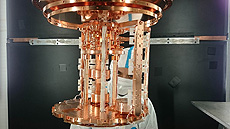The light side of dark matter
 |
New technology and new thinking are pushing the dark matter hunt to lower and lower masses. Photo: Karoline Schäffner/MPP |
It's a seemingly paradoxical but important question in particle physics: Can dark matter be light?
Light in this case refers to the mass of the as-yet undiscovered particle or group of particles that may make up dark matter, the unseen stuff that accounts for about 85 percent of all matter in the universe.
Ever more sensitive particle detectors, experimental hints and evolving theories about the makeup of dark matter are driving this expanding search for lighter and lighter particles — even below the mass of a single proton — with several experiments giving chase.
An alternative to WIMPs?
Theorized weakly interacting massive particles, or WIMPs, are counted among the leading candidates for dark matter particles. They most tidily fit some of the leading models.
Many scientists expected WIMPs might have a mass of around 100 billion electronvolts — about 100 times the mass of a proton. The fact that they haven't definitively showed up in searches covering a range from about 10 billion electronvolts to 1 trillion electronvolts has cracked the door to alternative theories about WIMPs and other candidate dark matter particles.
Possible low-energy signals measured at underground dark matter experiments CoGeNT in Minnesota and DAMA/LIBRA in Italy, along with earlier hints of dark matter particles in space observations of our galaxy's center by the Fermi Gamma-ray Space Telescope, excited interest in a mass range below about 11 billion electronvolts — roughly 11 times the mass of a proton.
Such low-energy particles could be thought of as lighter, "wimpier" WIMPs, or they could be a different kind of particles: light dark matter.
SuperCDMS, an WIMP-hunting experiment in the Soudan Underground Laboratory in Minnesota, created a special search mode, called CDMSlite, to make its detectors sensitive to particles with mass reaching below 5 billion electronvolts. With planned upgrades, CDMSlite should eventually be able to stretch down to detect particles with a mass about 50 times less than this.
In September, the CDMS collaboration released results that narrow the parameters used to search for light WIMPs in a mass range of 1.6 billion to 5.5 billion electronvolts.
Read more
—Glenn Roberts Jr.
|